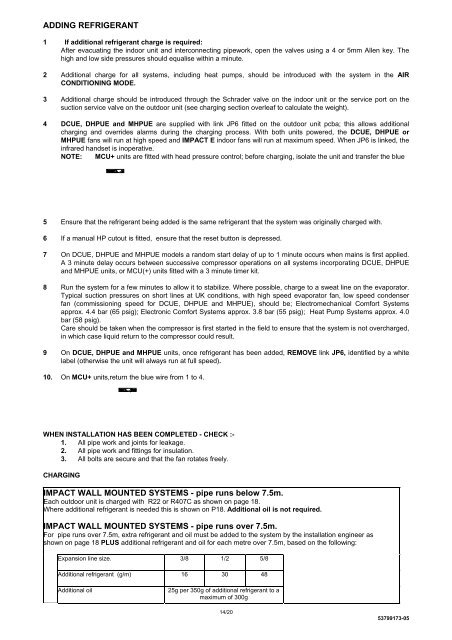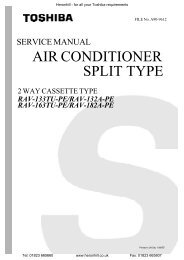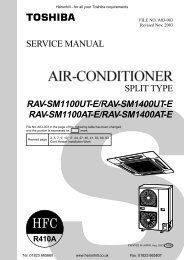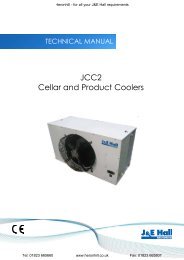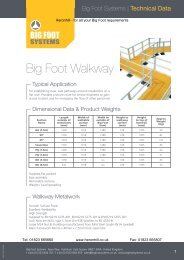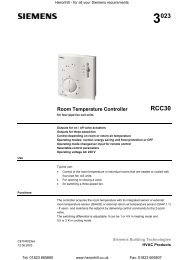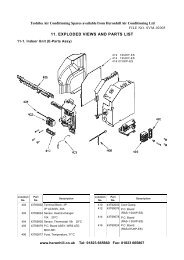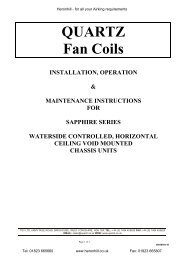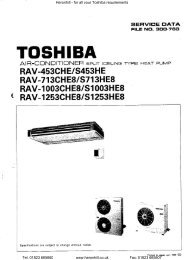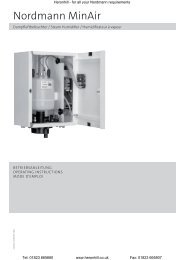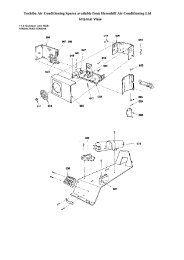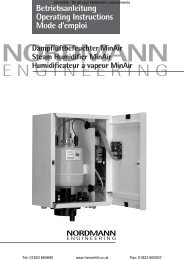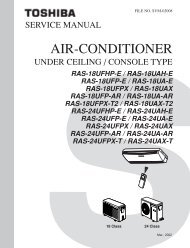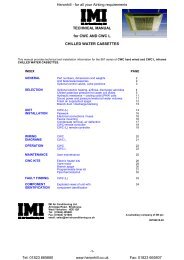impact / impact e wall mounted units technical manual - Heronhill Air ...
impact / impact e wall mounted units technical manual - Heronhill Air ...
impact / impact e wall mounted units technical manual - Heronhill Air ...
Create successful ePaper yourself
Turn your PDF publications into a flip-book with our unique Google optimized e-Paper software.
ADDING REFRIGERANT<br />
1 If additional refrigerant charge is required:<br />
After evacuating the indoor unit and interconnecting pipework, open the valves using a 4 or 5mm Allen key. The<br />
high and low side pressures should equalise within a minute.<br />
2 Additional charge for all systems, including heat pumps, should be introduced with the system in the AIR<br />
CONDITIONING MODE.<br />
3 Additional charge should be introduced through the Schrader valve on the indoor unit or the service port on the<br />
suction service valve on the outdoor unit (see charging section overleaf to calculate the weight).<br />
4 DCUE, DHPUE and MHPUE are supplied with link JP6 fitted on the outdoor unit pcba; this allows additional<br />
charging and overrides alarms during the charging process. With both <strong>units</strong> powered, the DCUE, DHPUE or<br />
MHPUE fans will run at high speed and IMPACT E indoor fans will run at maximum speed. When JP6 is linked, the<br />
infrared handset is inoperative.<br />
NOTE: MCU+ <strong>units</strong> are fitted with head pressure control; before charging, isolate the unit and transfer the blue<br />
5 Ensure that the refrigerant being added is the same refrigerant that the system was originally charged with.<br />
6 If a <strong>manual</strong> HP cutout is fitted, ensure that the reset button is depressed.<br />
7 On DCUE, DHPUE and MHPUE models a random start delay of up to 1 minute occurs when mains is first applied.<br />
A 3 minute delay occurs between successive compressor operations on all systems incorporating DCUE, DHPUE<br />
and MHPUE <strong>units</strong>, or MCU(+) <strong>units</strong> fitted with a 3 minute timer kit.<br />
8 Run the system for a few minutes to allow it to stabilize. Where possible, charge to a sweat line on the evaporator.<br />
Typical suction pressures on short lines at UK conditions, with high speed evaporator fan, low speed condenser<br />
fan (commissioning speed for DCUE, DHPUE and MHPUE), should be; Electromechanical Comfort Systems<br />
approx. 4.4 bar (65 psig); Electronic Comfort Systems approx. 3.8 bar (55 psig); Heat Pump Systems approx. 4.0<br />
bar (58 psig).<br />
Care should be taken when the compressor is first started in the field to ensure that the system is not overcharged,<br />
in which case liquid return to the compressor could result.<br />
9 On DCUE, DHPUE and MHPUE <strong>units</strong>, once refrigerant has been added, REMOVE link JP6, identified by a white<br />
label (otherwise the unit will always run at full speed).<br />
10. On MCU+ <strong>units</strong>,return the blue wire from 1 to 4.<br />
WHEN INSTALLATION HAS BEEN COMPLETED - CHECK :-<br />
1. All pipe work and joints for leakage.<br />
2. All pipe work and fittings for insulation.<br />
3. All bolts are secure and that the fan rotates freely.<br />
CHARGING<br />
IMPACT WALL MOUNTED SYSTEMS - pipe runs below 7.5m.<br />
Each outdoor unit is charged with R22 or R407C as shown on page 18.<br />
Where additional refrigerant is needed this is shown on P18. Additional oil is not required.<br />
IMPACT WALL MOUNTED SYSTEMS - pipe runs over 7.5m.<br />
For pipe runs over 7.5m, extra refrigerant and oil must be added to the system by the installation engineer as<br />
shown on page 18 PLUS additional refrigerant and oil for each metre over 7.5m, based on the following:<br />
Expansion line size. 3/8 1/2 5/8<br />
Additional refrigerant (g/m) 16 30 48<br />
Additional oil<br />
25g per 350g of additional refrigerant to a<br />
maximum of 300g<br />
14/20<br />
53799173-05


